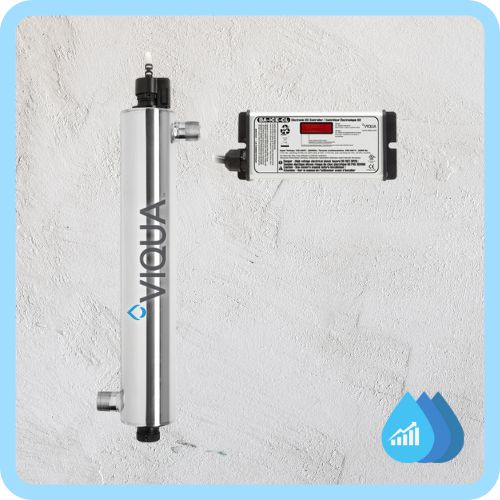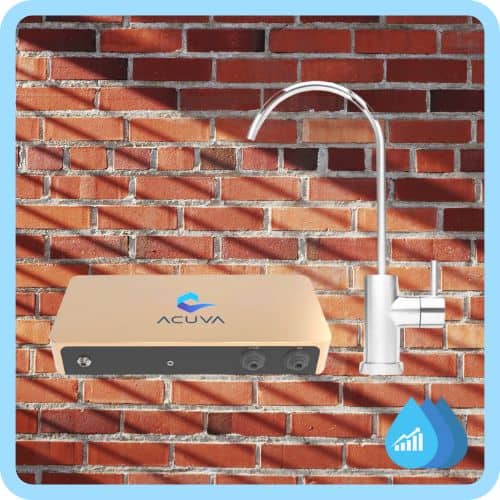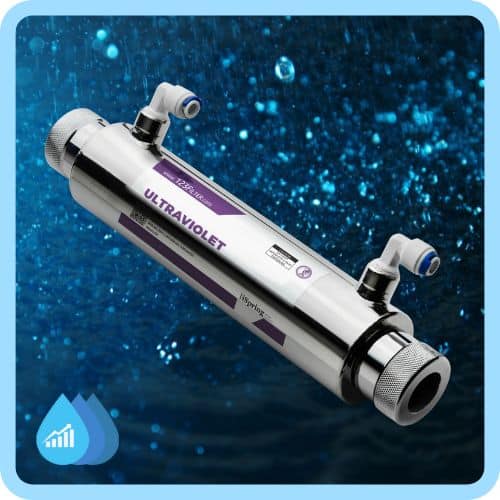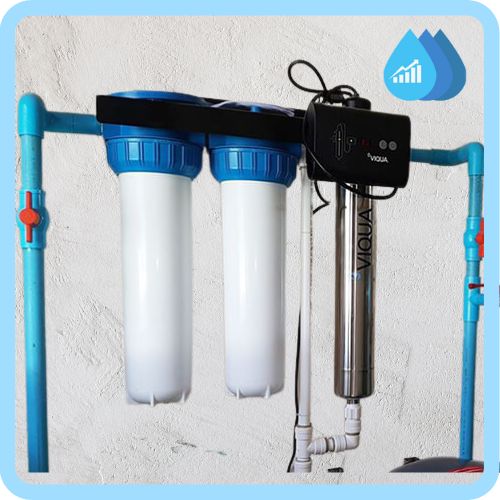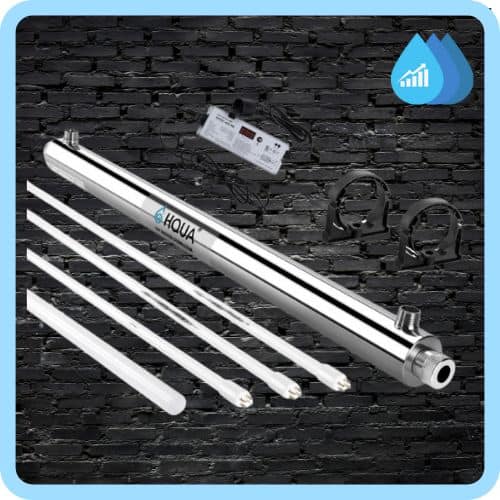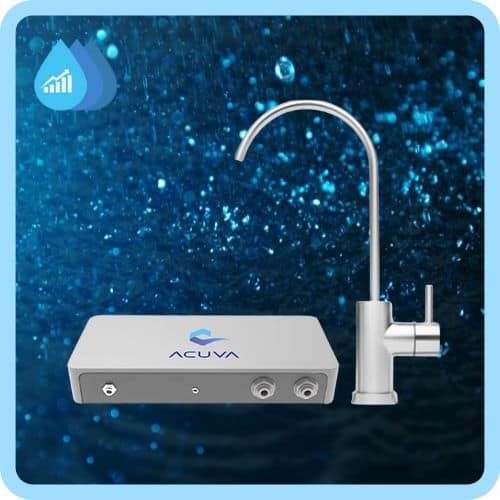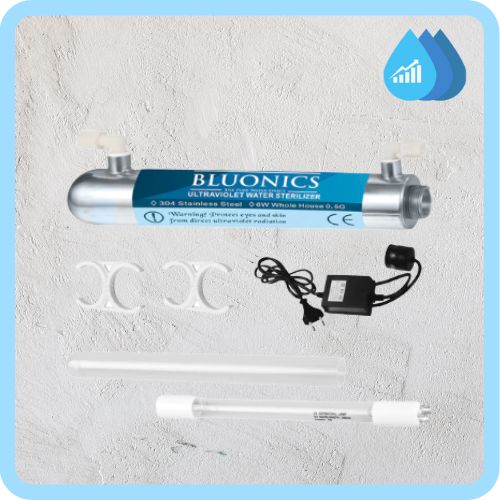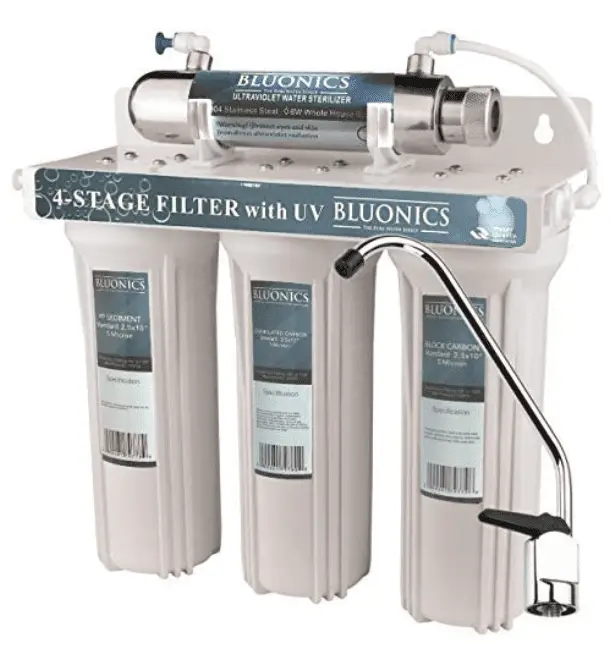In a hurry? Here are our top picks
Some of our readers contacted us to say they’d purchased a UV Water Filter but were disappointed with the results. The reasons why? Either they hadn’t checked whether their water was suitable for UV disinfection, or they didn’t need a UV system in the first place.
To ensure you don’t make the same mistake, we set off on a mission to detail who might need a UV purification system and how you can check your water is suitable.
Keep reading till the end for some pro tips for choosing the best UV water purifier for your situation.
The best UV water purifiers
- For larger households with wells: Viqua VH410
(Great Value for Money for up to 18GPM Flow Rate) > See Review
- For small households with wells: HQUA-TWS-12 Ultraviolet Water Purifier
(Cheap, Easy to Install, for up to 12GPM Flow Rate) > See Review
- Best for city water: Acuva ArrowMAX 2.0 UV-LED Water Purifier
(Low Maintenance & No Bulbs to Replace for up to 10 years) > See Review - Budget under-sink option: iSpring UVF11A
(Cheap, Under-Sink UV Filtration) > See Review
When & why you should use a UV light water purifier
First things first, a UV Purifier should never be your only water treatment solution. A UV Purifier should usually be installed as the final stage in your whole house filter setup.
UV water treatment can remove up to 99.999% of viruses, bacteria, and other microorganisms. So consider a UV water purifier if your water tests positive for coliform bacteria or viruses.
There are three main situations where UV water purifiers are needed:
- you have well water contaminated with microorganisms
- you have safe well water, but there is a risk of future contamination
- you live in an urban area that has frequent boil water warnings, and you’d like some extra peace of mind
If you currently have a water filter system and want to add further protection from microorganisms, then you should consider adding a standalone UV water purifier.
Likewise, if you don’t yet have a water filtration system (or want to replace an old whole house filtration system), choose from one of the combo whole house UV water filters we will discuss later.
What contaminants can UV remove?
- Bacteria
- E-Coli
- Cholera
- Flu
- Viruses
- Giardia
- Infectious Hepatitis
- Cysts
- Polio
- Meningitis
- Coliform
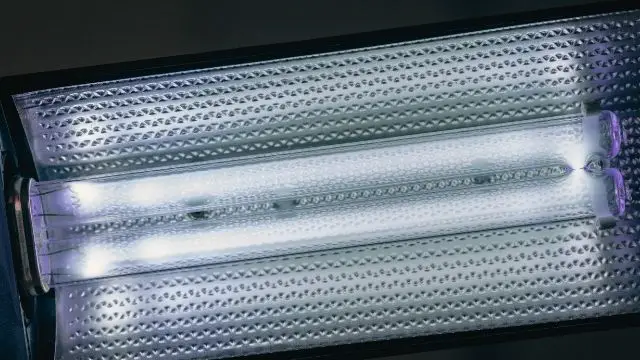
Next, let’s find out when UV disinfection is not suitable and dive into each of our main situations in more detail.
When a UV water purifier is unsuitable
UV light does not filter water in any way. So if your water has contaminants (like heavy metals, chlorine, chloride, pharmaceuticals, etc.) UV rays will not be able to deal with this.
If your water is NOT at risk of contamination by bacteria or viruses, then you do not need a UV purifier.
Choosing the best whole house UV purifier for well water
Here are some steps to follow when selecting a UV water purifier for well water:
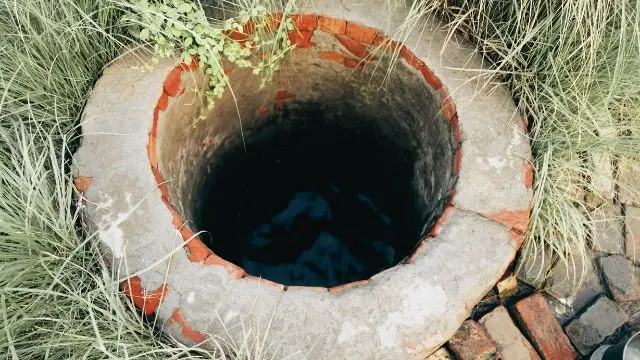
Know your water’s quality & check it meets the parameters of the UV unit
Even if your water is safe for drinking, it may not fit the parameters of your chosen UV system.
Most UV systems require your water to be pre-filtered, low in iron, hardness, and turbidity. For example, the Springwell Blackcomb UV Water Filter System has the following requirements:

- Hardness < 7 GPG
- Iron < 0.3 PPM
- Tannins < 0.1 PPM
- Turbidity < NTU
- Ultra Violet Transmission (UVT) > 85%
Use a reputable water testing company to check your water and be sure your choice of UV purifier is suitable. We recommend My Tap Score’s well water tests, which test for hardness and can tell you if your water is suitable for UV treatment.
For UVT testing, there are free options available, or you find a local provider to test your water for a small fee (more details below).
If you have a shallow well, you may find that turbidity and hardness are more prominent. In which case you should consider some of the most common well water filtration solutions or a softener designed for well water.
If your iron levels are high, install an iron filter before the UV filter.
Size your UV filter (go for one size up)
Here is where it’s easy to go wrong. You should always pick a UV system rated for a higher flow rate than your home’s current flow rate. This is because if your flow rate is too high, the UV light won’t have enough time in contact with the water to disinfect the water properly.
To find out your home’s current flow rate, you can do a simple test at home with just a bucket and your ears (see below).
Then choose a system rated at least 20% higher to give you some breathing space in case external factors change your flow rate. For example, if your home’s flow rate is 10GPM, you should consider a 12GPM system at a minimum.
Check you have space for installation
UV water purifiers are long and thin. So they’re usually quite easy to install.
But which way do you intend to install it?
Some UV systems can only be installed horizontally, whereas others can be installed both horizontally and vertically.
Check your requirements before making a decision.
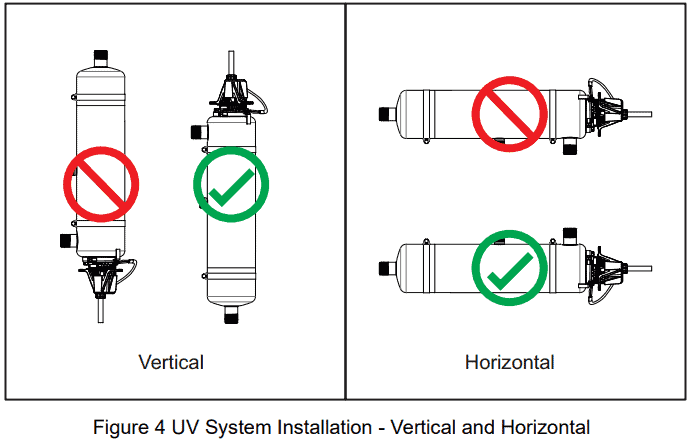
For example, the above diagram shows the Viqua VH410 can be installed both horizontally and vertically.
Select the best UV water purifier for your water
With all this information to hand, you’re ready to make your decision.
If you have a high flow rate, high turbidity, and low UVT in your water, you’ll need a more powerful UV system.
Conversely, a low flow rate, low turbidity, and high UVT will require a less powerful system.
For a large household (up to 18GPM flow rate), we recommend Viqua’s VH410. It’s a high-quality, long-lasting unit and great value for money.
For smaller households (up to 12GPM), we recommend HQUA’s TWS-12 Ultraviolet Water Purifier. It’s cheap, easy to install, and an excellent option for smaller homes.
Choosing the best UV purifier for municipal water (city water) or kitchen only
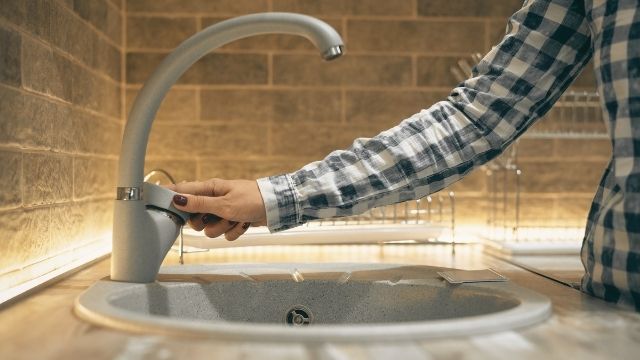
The risk of viruses, bacteria, and other microorganisms is relatively low for anybody living in a city or urban area with a public water supply. This is because authorities treat water to very high standards. That said, some areas are issued with boil water warnings much more frequently than others.
Alternatively, if your house uses well water, which you know is safe, but there is a small risk of contamination (for example, from local agriculture) adding a UV purifier under the kitchen sink my offer some extra peace of mind.
A faucet filter is an excellent option as an extra security blanket in either of these situations, ensuring your drinking water is always safe.
Here’s how to choose one.
Check the parameters of your water
As with whole-house UV water purifiers, you’ll need to check your current water system meets the parameters. For example, iSpring’s budget UVF11A has the following requirements.
Consider the installation location
Whatever you choose, you’ll need some space under your sink for the UV unit to be installed.
There are two main form factors:
- long, thin, cylindrical UV purifiers
- a small box UV filter (usually with an extra pre-filter)
For the long, thin, cylindrical models, you’ll need to check if you have enough space either vertically or horizontally. Horizontally will usually be the best option for most kitchens where free under-sink space is limited.
Small box UV filters are straightforward to install and need very little space. But these may also come with a pre-filter, so you’ll need to look at the installation instructions and dimensions to ensure you have space.
Think about the flow rate
An under-sink UV purifier may slow down your faucet’s flow rate.
If you choose a model with a separate filter, you can take your drinking water from a separate faucet. So you can wash the dishes with non-UV purified water with a faster flow rate and just use the faucet for drinking water.
If you install the water filter directly to your existing faucet, you’ll experience a decrease in flow rate. Consider whether this flow rate is high enough for washing the dishes and any other household chores you usually do at the kitchen sink.
Make your choice
Our favorite is the Acuva ArrowMAX 2.0.
It’s an all-in-one option with a pre-filter, so you don’t need to worry about installing extra filters. It’ll last up to 120,000 gallons, which ACUVA estimates should last most people seven years.
UV Water Purifier Reviews
Let’s take a more in-depth look at the products we’ve already mentioned, and explore a few alternatives.
Viqua VH410
Best for larger households with wells
| Price | $$$ |
| Flow rate | 18GPM |
| Required UVT | >75% |
| UV dose (strength) | 30mJ/cm2 |
| Installation direction | Horizontal or Vertical (vertical preferred) |
| Manual | 4.5/5 |
| Warranty | 10 years (chamber) / 3 years (ballast) |
| Yearly maintenance cost | ~$100 |
| Customer Service | 4.5/5 |
The VIQUA VH410 is perfect for large households with wells, and also for medium-sized homeowners who want to future-proof themselves in case of future flow rate increases.
It’s excellent value for money (around 50% cheaper than some premium brands). And it includes a lengthy warranty with great customer service to boot.
High UV dose (even at high flow rates)
This system can deliver 30mJ/cm2 of UV at a flow rate of 18GPM. That’s over double the US public health recommended dose, so you can be sure the VH410’s UV rays will eliminate viruses, bacteria, and other harmful pathogens.
Flexible installation & easy-to-follow manual
If you’re short on space, the VIQUA VH410 can be installed in either direction – handy for small basements already housing a large whole house water filter. And the manual is written in perfect English with easy-to-follow diagrams and instructions, so DIY installation should be possible for most people.
Responsive customer service
If you do have any problems, VIQUA’s customer service is helpful and quick to respond. When we contacted them and asked some complicated questions about installation and maintenance, we received a full and friendly response within 24 working hours.
Looking for an easy-to-install, high-powered UV filter with a flow rate that will keep you future-proofed? Check out the HQUA VH410 now.
An alternative choice:
Springwell Blackcomb UV Water Filter System
For premium build quality & lifetime peace of mind
If your budget can stretch, the Springwell Blackcomb UV Water Filter System is a fantastic premium option. SpringWell is known for its premium build quality and five-star customer service with lifetime warranties on its UV light chambers.
So if you’re looking for some extra peace of mind, the Springwell Blackcomb UV Purifier is a great alternative.
HQUA-TWS-12 Ultraviolet Water Purifier
Best for smaller households with wells
| Price | $$ |
| Flow rate | 12GPM |
| UV dose (strength) | 30mJ/cm2 |
| Installation direction | Vertical only |
| Customer Service | |
| Manual | 3.5/5 |
| Warranty | 10 years (chamber) / 1 year (ballast) |
| Yearly maintenance cost | ~$35 |
| Required UVT | > 75% |
HQUA’s TWS-12 UV Water Purifier is great for small and medium households. It’s budget-friendly and has the cheapest replacement bulbs of any UV purifier we could find.
Powerful UV-purifcation at 12GPM
The TWS-12 should be powerful enough for most small and medium-sized homes. At these levels, UV light can reduce microbes and bacteria by 99.9%.
Vertical installation only, easy(ish)-to-follow manual
If you only have space for a horizontal install, this isn’t the right choice for you as it can only be installed vertically. In this case, our alternative pick (see below) is the VIQUA VH410.
While the manual has some minor English mistakes, it was still understandable and won’t cause any confusion. There are some helpful diagrams to assist with installation, although they are a little technical. Some real-life photos would have made it easier to follow.
Easy maintenance, cheap replacement parts
As with all UV systems, UV lamps need replacing regularly. HQUA includes an extra bulb, so it should be two years before you need to think about replacements. When that time comes, it’ll only cost you $35-40 per UV lamp (the cheapest replacement UV bulb of this size we’ve ever seen!)
The ballast is an extremely simple model without unnecessary features. This means it’s less likely to go wrong; if it does, the replacements are much cheaper.
Good customer service, quick replacements in case of issues
Some users have reported broken bulbs on arrival or other problems like faulty ballast. Fortunately, it seems that HQUA is quick to solve customers’ problems and send out replacements (particularly on Amazon).
In our tests, they were a little slower than other manufacturers to respond to our questions (a little over 48 hours). But the answers provided were friendly and helpful.
HQUA’s TWS 12 is a winner for those looking for a budget-friendly option for small and medium houses. You’ll save money with the included replacement bulbs too. Click here to check it out.
An alternative choice: VIQUA VH10
for higher flow rates & installation flexibility
If you need a model effective at higher flow rates (up to 18GPM), we’d recommend the VIQUA VH10.
You can also install it in either direction, so it is a great alternative where space is lacking.
Acuva ArrowMAX 2.0 UV-LED Water Purifier
Best for city water & under sink
| Price | $$$$ |
| Flow rate | 5 liters per minute (1.3 gallons) |
| UV dose (strength) | >16 mJ/cm2 |
| Installation | Under-sink |
| Customer Service | |
| Manual | 5/5 |
| Warranty | 2 years |
| Yearly maintenance cost | $0 |
| Required UVT | n/a (suitable for all water) |
If you’re using city water or would like to add a little extra protection to the water you use every day, the Acuva- ArrowMax 2.0 is a great choice. It’s suitable for all water types, making it a great option for boats and RVs too. And you’ll never need to replace the UV lamp because it doesn’t use one!
Seven-year cost-free, worry-free use
Acuva’s ArrowMax 2.0 can purify up to 120,000 liters over its lifetime. This means the unit should last you seven years with virtually no maintenance.
This UV purification system doesn’t use a standard UV lamp. Instead, its UV light comes from LEDs which will last for the duration of the lifespan of the product.
Won’t slow you down
Undersink UV filter systems can slow down the speed at which water comes out of your tap. But the ArrowMax 2.0 has a separate faucet that can fill a glass with drinking water in less than 10 seconds.
And because there’s an extra faucet, you’ll still be able to turn on your old faucet when you need a faster flow (e.g., when doing the dishes or washing your hands).
Simple-to-install & top-quality support if you need it
Multiple reviews mention how easy the system is to install (even for clumsy people!) And it’s easy to see why. The manual is one of the best we’ve looked at, with clear 3D diagrams. It’s written in plain English and is easy to follow.
We got in touch with ACUVA with some basic questions about the system. We received quick, friendly responses (and other online reviews confirm this too). We couldn’t find reports of people needing help due to faulty parts – probably a good thing – but we’d expect ACUVA to be helpful if this did happen.
Need a UV purifier that installs under the sink in less than an hour? Get up and running today with pure UV water from the Acuva ArrowMax 2.0.
An alternative choice: Acuva ArrowMax 1.0
for boats, RVs, or for extra savings if speed isn’t an issue
If you’re not worried about the speed your drinking water comes out of the faucet, the Acuva’s ArrowMax 1.0 could make you a significant saving.
It only provides 1L of purified water per minute and has a lifespan of 60,000L (compared to 5L/minute and 120,000L of the ArrowMax 2.0). But this makes a great alternative for occasional use, particularly for RVs or boats.
iSpring UVF11A
Best budget under-sink UV purifier
| Price | $ |
| Flow rate | 1 GPM |
| UV dose (strength) | 11W UV lamp |
| Installation direction | Vertical or horizontal |
| Customer Service | 4.5/5 |
| Manual | 4/5 |
| Warranty | 1-year limited warranty |
| Yearly maintenance cost | ~$30 |
| Required UVT | > 70% |
The iSpring UVF11A great option as an add-on to an RO system or other under-sink filtration system. And if you’re on a budget, this is a fantastic way to add UV filtration to your existing setup.
Auto-switch off to save electricity & increase bulb life
One of the standout features of this model is the automatic sensor, which powers down the bulb when your faucet is not in use. Not only does this save you electricity, but you’ll extend the life of your UV lamps and spend less money on replacements.
Simple install with personalized support
Nearly all users report the unit is straightforward to install. Watch for common mistakes like tightening the plastic elbow too much or installing the flow switch round the wrong way.
If anything breaks, you’ll find the guys at iSpring helpful and ready to send out replacement parts (often on the same day). Sean & Brian at iSpring are frequently mentioned as providing great customer support. The stainless-steel chamber should protect the UV purification system inside. Still, it’s nice to know that support from a real person is there if needed.
We fired off a quick email with a few questions about the UVF11A and got quick, friendly advice the same day.
An alternative choice: Bluonics 6W-UV
super low-budget option
We’re unfamiliar with the Bluonics brand, but the Bluonics 6W-UV is the cheapest under-sink UV purifier we found.
And as it has mostly great reviews and similar specifications to the iSpring model, it might be a good option for those with a tight budget.
How do UV water purifiers work?
A UV water filter works by passing water through a UV lamp. The UV radiation from the lamp kills any microorganisms in the water, including bacteria, viruses, and protozoa.
The Science of UV Disinfection
UV disinfection is a process that uses UV radiation to kill any microorganisms in the water. The UV radiation destroys the DNA of the microorganisms, which prevents them from reproducing and spreading.
The Main Components of a UV Water Filter
The main components of a UV water filter are a UV lamp, quartz sleeve, and controller (also known as a ballast).
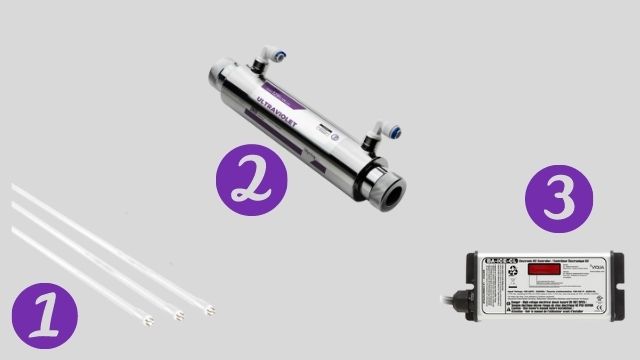
- The UV lamp emits UV radiation that kills any microorganisms in the water.
- The quartz sleeve (a.k.a UV chamber) protects the UV lamp inside from debris and sediment in the water.
- The ballast monitors the water flow and UV intensity to ensure the filter works properly.
Pro Tips for Buying a UV Water Filter
Don’t just buy the first UV purifier you find. Follow our pro tips below to make sure you’re making the right decision.
Get a Free UVT Check
Ultra-Violet Transmission (UVT) measures how much UV light can pass through your water. Most UV water purifiers require your water to be between 75 and 85% UVT to work effectively.
UVT meters are very costly (thousands of dollars), so it doesn’t make sense for homeowners to buy one.
If your water looks cloudy or has high iron or tannins, you should check a sample for UVT.
Search for a local provider of UVT testing online, ask the manufacturer of the UV light you intend to purchase, or check out Home Plus Water, who offer free UVT testing.
Get a water test with results in five days
As mentioned, a UV purifier will have maximum parameters for things like iron, manganese, and tannins.
We recommend MyTapScore’s well water test for anyone unsure about their water quality.
If your iron levels are too high for a UV filter, consider one of the iron filters we’ve previously reviewed here.
Note: commercial water quality tests like these do not usually test for UVT. So refer to the section above for how to test for UVT.
Measure your flow rate at home
You don’t need a plumber or any special material to do this at home.
For a well, you’ll need to find out how many gallons ‘draw down’ there is (i.e., the amount of water your pressure tank stores before the well pump kicks in). Then you’ll need to time how long it takes for the pump cycle to complete (i.e., how long it takes for the pump to turn off again).
You can then use the formula: (gallons drawn / pump cycle time) x 60 = Gallons per Minute (GPM) flow rate. Check out the full guide here: https://affordablewater.us/Determine-Your-Well-Flow-Rate
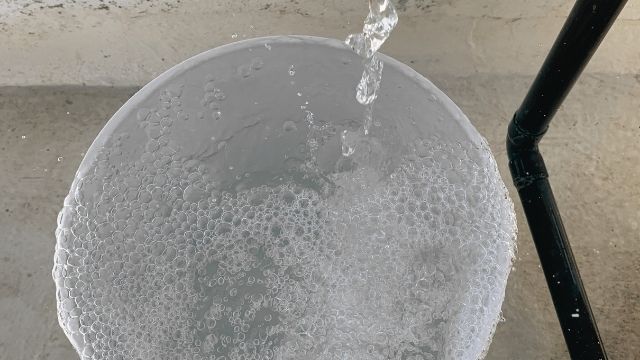
For a home faucet, this is much simpler. Just time how long it takes to fill a one-gallon from your faucet. Then you just need the simple formula of (60 / seconds taken to fill the container = Flow Rate in GPM).
Read the manual
Before buying, check the manual. There are two reasons for this.
Firstly, a UV water purifier with a well-written manual with clear diagrams and pictures is likely to be higher quality. If the manufacturer hasn’t put effort into making a high-quality manual, how can we trust their overall product?
Secondly, the manual contains details like required water parameters, installation instructions, and maintenance details. A quick check of the manual ensures the UV system is suitable for your home, and you don’t end up with any nasty surprises.
Consider a mini rack for installation
Mini racks are easier to install, and you don’t need to worry about mounting them on a wall.
A mini rack takes out all of the complications of installation. You’ll need fewer tools and less time to get up and running.
For example, this all-in-one system from Bluonics includes a rack with the UV filter mounted at the top. This makes installation simple as you’ll only need to mount the rack. After that, everything else just slots into place.
Beware of unnecessary features
Some UV filters have many bells and whistles that aren’t particularly useful for most people.
After the UV lamp, ballasts are the next most common thing to malfunction. And if there are lots of lights, dials, and indicators, it will increase the likelihood of a malfunction and also be more expensive to replace.
Calculate your maintenance costs
As with all water filters, the upfront cost isn’t the only consideration. Check how much the UV lamps cost and how often you need to replace them.
In our product reviews above, we checked the cost of replacement lamps and the replacement frequency to estimate yearly maintenance costs.
Frequently Asked Questions
How long does a UV water filter last?
You can expect the whole UV purifying unit to last ten years or more.
The UV bulbs, however, typically need to be replaced every 6-12 months.
Is UV water better than Ro?
In our opinion, neither RO nor UV purification is better than the other. UV filtration makes a great addition to a Reverse Osmosis System. We recommend iSpring’s UVF11A as a great under-sink UV lamp and a great addition to any RO system.
Do you need a UV filter for city water?
In general, no, you shouldn’t need a UV lamp purifier for city water. City water is treated with chlorine, which acts as a disinfectant.
However, if you have reasons to believe that your water is at risk of contamination, then UV disinfection may be worth considering.
What are the disadvantages of UV water purification?
The main disadvantage of UV water purifiers is that they require electricity. Additionally, a UV lamp cannot remove minerals, metals, or other dissolved solids from your water.
Can UV light sterilize water?
Yes, UV light can sterilize water which is why the process is often referred to as UV disinfection. It is a common method of purifying water, and UV rays effectively eliminate bacteria, viruses, and other microorganisms.

